Mushrooms
Media
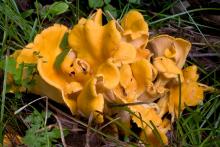
Species Types
Scientific Name
Cantharellaceae (various members of family)
Description
Chanterelles are funnel- or trumpet-shaped and have wavy cap edges. Most are bright orange or yellow, although one, the black trumpet, is brownish black.
Media

Species Types
Scientific Name
Desarmillaria caespitosa (formerly Armillaria tabescens)
Description
The ringless honey mushroom is honey-colored, with a dry, scaly cap, and lacks a ring on the stalk. It grows in clusters at the bases of trees or stumps, especially of oaks, and over buried wood.
Media

Species Types
Scientific Name
Agaricus campestris
Description
The meadow mushroom has a smooth white to light grayish cap and pinkish brown gills. It's found in lawns and other grassy areas.
Media

Species Types
Scientific Name
Laccaria ochropurpurea
Description
The purple-gilled laccaria has a large, tannish lavender cap with thick, purplish gills and a stout stalk. It grows scattered or in groups in grassy areas and under hardwoods and conifers.
Media
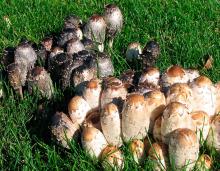
Species Types
Scientific Name
Coprinus comatus
Description
The shaggy mane has a white, shaggy, cylindrical cap that turns black and inky. It often grows in large numbers along roadsides and in lawns and disturbed areas.
Media

Species Types
Scientific Name
Phlebia incarnata (formerly Merulius incarnatus)
Description
The coral-pink merulius is a small, semicircular bracket fungus that is pinkish to coral to cream-colored, wrinkled, and veined beneath. It grows on dead logs and stumps of deciduous trees.
Media
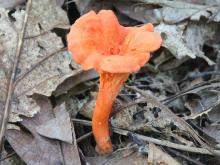
Species Types
Scientific Name
Cantharellus cinnabarinus
Description
The cinnabar chanterelle is a small, reddish orange, vase-shaped mushroom with forked ridges on the underside that descend the stalk. It grows in the soil.
Media
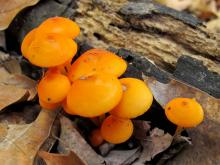
Species Types
Scientific Name
Mycena leaiana
Description
The orange mycena is a small, sticky, bell-shaped, orange mushroom. It grows in dense clusters on deciduous wood.
Media
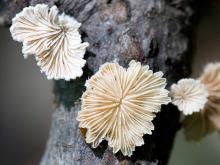
Species Types
Scientific Name
Schizophyllum commune
Description
Split gills grow in clusters with small, white, hairy, fan-shaped caps. Beneath, they have whitish or pinkish gill-like folds that split toward the edge. They grow on dead branches of deciduous trees.
Media
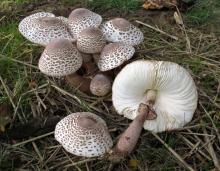
Species Types
Scientific Name
Leucoagaricus americanus (Lepiota americana)
Description
The reddening lepiota is a large, reddish brown mushroom with a scaly cap and a ring on the stalk; it bruises dark red. It grows singly or in clusters in mulch piles, waste areas, and around stumps.
See Also



Media

Species Types
Scientific Name
Monotropa hypopitys
Description
Pinesap is a plant that puts the "wild" in wildflower! It lacks chlorophyll, so its roots connect to fungi underground and absorb nutrients from the fungi.
Media

Species Types
Scientific Name
Cladophora, Pithophora, and Spirogyra spp., and others
Description
Filamentous green algae forms green, cottony masses that are free-floating or attached to rocks, debris, or other plants.
Media

Species Types
Scientific Name
Monotropa uniflora
Description
Indian pipe lacks chlorophyll, so it is white, not green. Below ground, its roots join with fungi that connect to tree roots. This plant, then, takes nourishment indirectly from the trees.
About Mushrooms in Missouri
Mushrooms are a lot like plants, but they lack chlorophyll and have to take nutrients from other materials. Mushrooms are neither plants nor animals. They are in a different kingdom — the fungi. Fungi include the familiar mushroom-forming species, plus the yeasts, molds, smuts, and rusts.
Always be cautious when eating edible mushrooms. Be absolutely sure of the ID, and only eat a small amount the first time you try it to avoid a reaction..





















